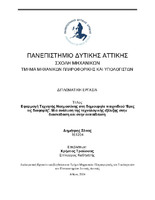Εφαρμογή τεχνητής νοημοσύνης στη δημιουργία παιχνιδιού ‘Βρες τις διαφορές’. Μια ανάλυση της τεχνολογικής εξέλιξης στην διασκέδαση και στην εκπαίδευση
Application of AI in the creation of the game 'Find the differences'. An analysis of technological evolution in entertainment and education

Λέξεις-κλειδιά
Τεχνητή νοημοσύνη ; Βιντεοπαιχνίδια ; ΔιδασκαλίαΠερίληψη
Η παρούσα διπλωματική εργασία επικεντρώνεται στη δημιουργία ενός παιχνιδιού με την
ονομασία «Βρες τις διαφορές» ένα απλό παιχνίδι με απλούς κανόνες καθώς ο παίχτης ως στόχο
να βρει τις διαφορές μεταξύ δύο εικόνων. Το παιχνίδι χρησιμοποιεί Τεχνητή Νοημοσύνη και πιο
συγκεκριμένα το μοντέλο μηχανικής μάθησης (Decision Tree Classifier), ώστε να μπορεί να
προβλέψει την απόδοση με βάση νέες εισόδους και το οποίο διακρίνεται για την καινοτομία του
να απαιτεί από τον παίκτη να εντοπίσει τις διαφορές μεταξύ πανομοιότυπων εικόνων καθώς ο
χρόνος κυλάει έως ότου ο χρήστης βρει τις διαφορές. Το παιχνίδι προσαρμόζει δυναμικά το
επίπεδο δυσκολίας, λαμβάνοντας υπόψη τον αριθμό των εντοπισμένων διαφορών και τον χρόνο
που απαιτείται για την ολοκλήρωση.
Η εργασία αναλύει εκτενώς τον εκπαιδευτικό αλλά και τον ψυχαγωγικό χαρακτήρα των
παιχνιδιών και τη συμβολή της τεχνητής νοημοσύνης στον τομέα της εκπαίδευσης και της
διδασκαλίας. Επιπλέον, εξετάζεται αναλυτικά ο σχεδιασμός του , η υλοποίηση του καθώς επίσης
και οι μέθοδοι που χρησιμοποιήθηκαν για να επιτευχθεί το παιχνίδι "Βρες τις Διαφορές",
προσφέροντας μια περαιτέρω ενίσχυση της κατανόησης της διαδικασίας ανάπτυξης. Μέσα από
αυτήν την εκτενή ανάλυση, αναδεικνύεται η σημασία της τεχνητής νοημοσύνης στον τομέα της
εκπαίδευσης μέσω των παιχνιδιών.
Περίληψη
This thesis focuses on the creation of a game called "Find the Differences" a simple game
with simple rules as the player aims to find the differences between two pictures. The game uses
Artificial Intelligence and more specifically the machine learning model (Decision Tree Classifier)
to be able to predict performance based on new inputs and which is distinguished by the novelty
of requiring the player to identify the differences between identical images as time ticks by until
the user finds the differences. The game dynamically adjusts the difficulty level, taking into
account the number of differences detected and the time required for completion.
The paper extensively discusses the educational as well as recreational nature of games and
the contribution of artificial intelligence in the field of education and teaching. In addition, the
design, the implementation as well as the methods used to achieve the "Find the Differences" game
are discussed in detail, offering a further enhancement of the understanding of the development
process. Through this extensive analysis, the importance of artificial intelligence in the field of
education through games is highlighted.

